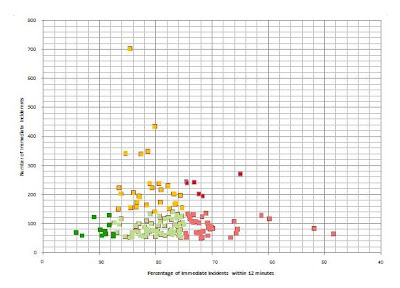
"CrimeReports has found that sharing crime data publically breeds trust in local law enforcement and provides citizens with a way to keep themselves informed. When law enforcement shares data with the pubic, they are entrusting citizens with the power to participate in their own crime prevention efforts. Citizens feel like they are in control. And in return, the citizens give that trust back to the law enforcement agency." This is a quote from James Gunter in this
post on his blog. This sounds a bit like a sales pitch but it is an
assertion that I agree with but I would not limit it to the sharing of crime data - more about that later. It fits in with my understanding of the published academic research in this area which I am very interested in because I want to be able to link the performance measure of confidence in the police back to fear of crime via police activity, most
notably police patrols.
I try to devise simple diagrams or models for myself to allow me to ruminate over a particular concept. I have shared one already about the fear of crime in a previous
post. Today I am sharing another one of my fear of crime diagrams to help try to explain how the partnership approach between the police and the public can work to their mutual benefits. It is all based on good communication.
Firstly let me try to explain the diagram above in a few sentences. I hope to publish a more detailed discussion in the next few weeks that I will link to this blog.
The diagram is called the PAW model not because it looks like a paw of a dog or cat but because I argue, based on numerous academic sources, that "fear of crime" is made up of three separate and sequential elements - Perception, Assessment and Worry.
- Perception is a global view about the level and nature of crime and disorder
- Assessment is where that perception is applied personally in a way that the risk of being a victim of crime can be avoided or mitigated
- Worry occurs if the risk cannot be avoided or mitigated
Confidence in Police is linked to people's perception of crime and disorder and how effective and efficient police are at dealing with it. Generally people accept that it is their responsibility not police to assess the dangers and act sensibly. Worry is the negative aspect of fear of crime and occurs mainly where people live or have to go - places and times people cannot avoid. This the reason why prioritising residential crimes is a correct policy.
How does communication, such as, Internet crime mapping fit in? Fear of crime spirals out of proportion to reality when perception of crime and disorder is wrong. This can lead to inappropriate crime prevention and unnecessary worry. Police, by providing information allows more accurate perceptions of the crime and disorder problems leading to positive crime prevention and worry outcomes. This, if done correctly, leads to the public feeling that the police are on their side working to tackle the problems that affect them, thus increasing confidence in their police.
 George Orwell was one of the great Englishman of the 20th Century. An enigma in many ways. An Eton scholar who became a colonial police officer, who fought with communists in Spain, who saw the tyranny of totalitarianism and fundamentalism in whatever form, who became an informant for the British establishment. I do not think he was a writer of genius but he wrote about great and important principles that he lived out himself. He viewed life from the eyes of the oppressed and disenfranchised but he saw through those who exploited them for their own ends with the message of liberty, equality and friendship.
George Orwell was one of the great Englishman of the 20th Century. An enigma in many ways. An Eton scholar who became a colonial police officer, who fought with communists in Spain, who saw the tyranny of totalitarianism and fundamentalism in whatever form, who became an informant for the British establishment. I do not think he was a writer of genius but he wrote about great and important principles that he lived out himself. He viewed life from the eyes of the oppressed and disenfranchised but he saw through those who exploited them for their own ends with the message of liberty, equality and friendship.























